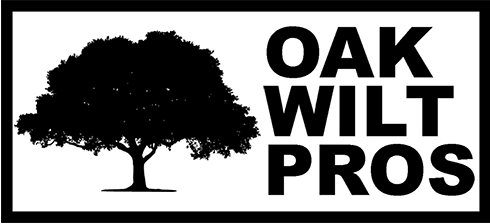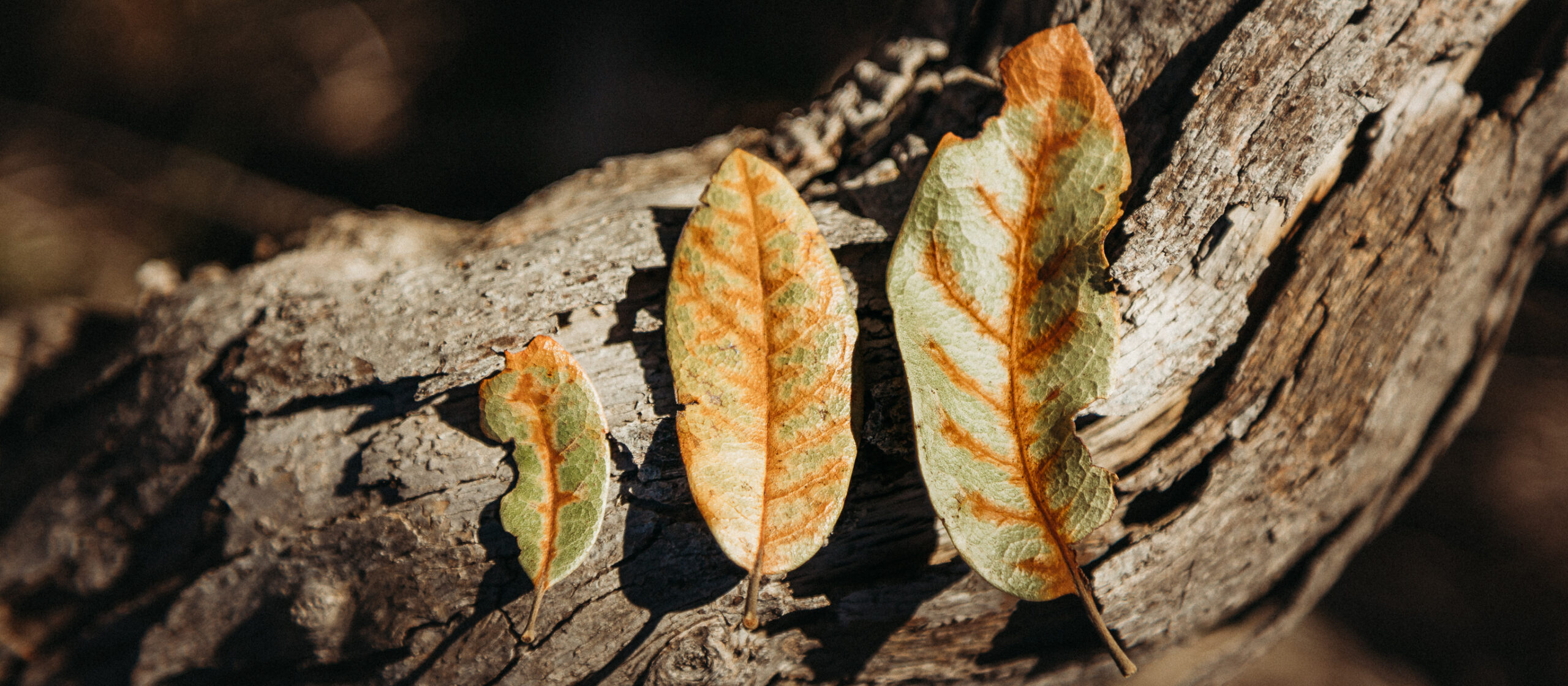Oak wilt is a devastating disease affecting vast swathes of Central Texas oaks, rendering immediate and expert action imperative.
Arborists utilizing advanced treatment methodologies are the vanguard against this relentless pathogen – a shield of arboreal health in a vulnerable ecosystem.
Identifying Oak Wilt
Oak wilt identification begins with close observation of foliage symptoms. Leaves rapidly wilt, displaying a telltale bronze to tan discoloration, signalling the tree’s distress. Early detection is critical for effective intervention.
Look for distinctive patterns of leaf loss starting at the crown and working downward, coupled with a distinct discoloration along the veins. These are classic symptoms that warrant professional assessment, especially during late spring and summer. Live oaks are semi-deciduous and any canopy loss or stress should receive a closer look.
Fungal mats producing a sweet, fermenting odor may also emerge under the bark. These signs necessitate immediate expert consultation to confirm presence and strategize containment.
Signs & Symptoms
Initial evidence of oak wilt manifests in leaf discoloration—often a bronze to tan hue—indicative of vascular distress.
Rapid defoliation often accompanies leaf bronzing, raising the urgency for specialized arboricultural intervention.
Affected oaks may exhibit a distinct pattern: foliage browning at the tips and margins, followed by inward progression toward the leaf base. Veinal necrosis or veinal banding with pronounced veins on leaves on or beneath live oaks can indicate the presence of disease.
Fungal mats beneath the bark, which secrete a pungent odor, can indicate advanced infection, necessitating prompt professional evaluation. This would only be present on diseased red oaks.
Importance of Early Detection
Early detection of oak wilt can dramatically alter the disease’s impact, saving valuable trees and reducing the spread.
- Rapid Response: Prompt treatment can mitigate damage and help preserve the tree’s structural integrity.
- Cost Efficiency: Early action often requires less invasive measures, translating to lower overall management costs.
- Disease Containment: Detecting oak wilt quickly enables faster implementation of strategic barriers, such as trenching, to halt disease progression.
- Preservation of Ecosystem: By catching the infection early, it minimizes the risk to surrounding vegetation, preserving the local ecology.
An accurate diagnosis reinforces the effectiveness of subsequent treatments and interventions.
Consistent surveillance and professional evaluations are key to safeguarding oak populations against this aggressive pathogen.
Fungicide Injection Treatment
Administering fungicide through macro-injection directly targets the oak wilt pathogen, providing immediate intervention within the tree’s vascular system. This method ensures a thorough distribution of the treatment, enhancing the tree’s resistance to the spread of the disease. Essentially protecting a tree and suppressing disease to the root systems. Early implementation of this technique is critical for success, emphasizing the need for vigilant monitoring and rapid deployment when symptoms first appear. Treating trees near disease prior to symptoms is preferred for best results.
The injection process requires precision and expertise to maximize efficacy and safeguard the tree’s health. Utilizing Alamo, our skilled arborists deliver systemic protection that permeates the entire canopy, fortifying oaks against this destructive disease with minimal environmental disruption.
The Role of Propiconazole
Propiconazole is a systemic fungicide integral to the management of oak wilt disease. It serves to inhibit fungal growth, preserving the integrity of infected oaks.
As a triazole, propiconazole operates by upsetting the fungal cell membrane and blocking ergosterol synthesis, a vital component of the fungal cell wall. This disruption effectively halts the progression of the oak wilt pathogen, shielding the tree from further damage. When properly administered, the protective fungicide barrier extends throughout the tree, curbing the establishment and spread of the pathogen within its intricate vascular network.
The timing of propiconazole treatments is a critical factor determining the outcome of intervention. To maximize effectiveness, treatments should be as preventative as possible, before the disease has a chance to advance and cause significant vascular damage.
Moreover, the skillful application of propiconazole is paramount. Incorrect dosage or injection techniques can lead to suboptimal results or, in some cases, further harm to the tree. Therefore, the expertise of ISA certified arborists is indispensable for administering this fungicide responsibly, ensuring the longevity of oak populations while maintaining ecological balance.
Injection Techniques & Success Factors
The art of macro-injection is nuanced.
Precision during fungicide application is non-negotiable. The rate at which the propiconazole is introduced, the location of the injection points, and the timing all have profound implications for efficacy. It’s crucial these factors are calibrated to the tree’s specific needs. Moreover, conscientious adherence to industry standards is essential to avoid potential phytotoxicity that could compromise tree health.
Expertise ensures precision and success.
The proficiency of the arborist is crucial – their knowledge defines the procedure. Arborists must be well-versed in identifying the optimal injection sites and deploying the fungicide at appropriate pressure levels to ensure thorough distribution within the tree’s vascular system.
Advanced diagnostic tools refine treatment plans.
Ongoing research and development of injection technologies play pivotal roles in enhancing treatment success. Embracing innovations offers the opportunity to improve application accuracy and treatment outcomes. Our practices reflect cutting-edge advancements, solidifying our commitment to the health of your oaks.
Trenching to Prevent Spread
Intervention through trenching disjoints continua of root networks harboring the maligned pathogen, subverting its subterranean migration. This strategic severance necessitates expert excavation, adhering to arboricultural protocol, to preemptively halt the insidious spread of oak wilt.
Our trenching methodologies are meticulously executed, enacting a physical barrier to shield healthy oak populations. Deploying this tactic forms an indispensable cornerstone in the grand strategy of oak wilt management and containment.
Understanding Root Transmission
Oak wilt spreads through interconnected root systems, threatening entire groups of oaks.
- Root Graft Formation: Neighboring oak trees naturally form root grafts, which create potential pathways for disease transmission.
- Pathogen Spread: The oak wilt fungus travels via these grafts, infecting adjacent healthy trees with remarkable efficiency.
- Breaking the Chain: Trenching severs these connections, providing a physical barrier against this underground advance of the pathogen.
- Prevention Measures: Strategic separation of roots is essential for the containment and long-term management of oak wilt outbreaks.
Early intervention is crucial to disrupt this mode of transmission.
Implementing these tactics safeguards oaks against the spread of this devastating disease.
The Science Behind Trench Depths
Oak wilt transmission is not a superficial occurrence, reaching depths that can surprise even the most seasoned experts.
When oak roots graft together, they form a seamless conduit for the oak wilt fungus, which does not respect the boundaries set by the soil surface. Instead, the pathogen exploits the interconnected network often extending more than four feet deep. By trenching at least 48 inches, we effectively disrupt these subterranean connections, thereby severing the disease’s lifeline and halting its spread.
Depth selection for trenching is driven by root biology and the fungus’s behavior. Roots, especially those of oak trees, have no fixed depth. They grow and intertwine wherever conditions are favorable. Observational studies and practical experience suggest that the majority of significant root grafts occur within the top four feet of soil. Therefore, a trench deeper than 48 inches maximizes the probability of severing all vital grafts.
Moreover, considering Central Texas’s variable soil conditions, a one-size-fits-all approach for trenching depth does not suffice. By exceeding the Texas Forest Service standard and trenching to 52 inches, we accommodate varying soil profiles and ensure that root connections are decisively disrupted. This meticulous trenching depth not only reduces the possibility of residual connected roots but acts as an insurance against the resilience and potential return of the pathogen.
Professional Oak Wilt Inspections
Conducting comprehensive oak wilt inspections requires astute observation and detailed analysis of the affected trees and surrounding environment. Our certified arborists rigorously examine your oaks for symptoms of oak wilt and evaluate the health of your arboreal assets.
When our professionals inspect a property, they bring a wealth of expertise, scrutinizing the tree canopy, foliage, and root zone. Early detection is critical in managing oak wilt, hence our focus on identifying early signs of infection and assessing the potential for disease spread.
A succinct, expertly crafted report caps off our inspection process. This document provides actionable insights, outlining potential treatments and preventive measures to safeguard your oaks against this devastating disease.
What to Expect During an Inspection
Upon arrival, our certified arborist will greet you, briefing on the process ahead and what will be assessed during the inspection.
Methodically moving through your property, the expert will survey each oak tree, meticulously examining its condition, including the foliage, bark, and root flare. The scrutiny extends to identifying symptoms exclusive to oak wilt, such as leaf discoloration, defoliation, and fungal mats. Noting these symptoms is pivotal, as they are indicative of the disease’s presence and severity. Sampling can be completed when on-site diagnosis is inconclusive. This is often performed for owners as it can take 3-4 weeks for results which is not ideal for a buyer’s timeline.
Moreover, the inspection entails a thorough evaluation of your land’s topography, soil conditions, and the distribution of oaks. Our expertise encompasses understanding the environmental factors that may influence the transmission and progression of the oak wilt fungus within your arboreta.
Finally, we’ll conclude with an in-depth debrief, where our findings are communicated with clarity. Expect a comprehensive report that encapsulates the health status of your trees, recommended intervention measures, and the associated action plans. This proactive approach to oak wilt management is the bulwark that shields your oaks from the devastating impact of this pathogenic adversary, ensuring longevity for your treasured natural assets.
Interpreting Inspection Reports
Upon receiving your inspection report, immediate comprehension is imperative for timely decision-making and action. Each document will succinctly detail the identified oak wilt symptoms, the extent of infection, and potential risk areas with recommended courses of action.
It’s essential to scrutinize the suggested treatment options—ranging from macro-injection to tactical trenching—set against the severity of infection. The report provides a cogent summary of the pros and cons of each treatment, facilitating a judicious choice that balances efficacy with ecological impact.
Understanding the fiscal aspect is also crucial. The report estimates the financial implication of the recommended treatment and prevention strategies. It’s designed to equip you with a transparent cost-benefit analysis aiding in the allocation of resources. This detailed financial forecast can streamline proactive planning and ensure the sustainability of your bespoke oak wilt management program.

